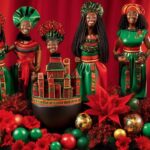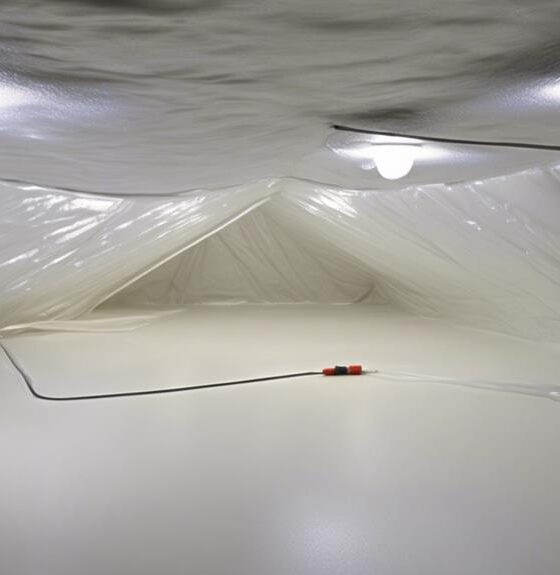Decor
Alabama Kwanzaa Decorations: Southern Heritage and Celebratory Spirit

Delving into Alabama’s vibrant Kwanzaa festivities, we find ourselves surrounded by a world where heritage and tradition merge seamlessly with a festive spirit. Kwanzaa, deeply embedded in African-American traditions, occupies a cherished position among the people of Alabama, serving as a medium to celebrate and pay homage to their Southern roots.
In this article, we delve into the unique decorations that adorn Alabama's Kwanzaa festivities, showcasing the blending of Southern themes with the traditional symbols of Kwanzaa. From vibrant centerpieces to homemade ornaments that exude a Southern flair, Alabama's Kwanzaa decorations reflect the joy and unity that this holiday brings to communities across the state.
Join us as we delve into the captivating world of Alabama's Kwanzaa decorations and discover the beauty of Southern heritage and celebratory spirit.
Key Takeaways
- Kwanzaa in Alabama fosters unity and celebration among diverse communities.
- Alabama's Kwanzaa traditions reflect the vibrant cultural tapestry of the African-American community.
- Incorporating Southern themes into Kwanzaa decorations honors Alabama's history and heritage.
- Alabama's Kwanzaa decorations reflect the state's southern heritage and add to the celebratory spirit.
Significance of Kwanzaa in Alabama
Kwanzaa holds significant cultural importance in Alabama, fostering a sense of unity and celebration among its diverse communities. Kwanzaa celebrations in Alabama bring together people from different backgrounds to honor African American heritage and traditions. This holiday has a profound impact on Alabama's African American community, providing a space for connection, reflection, and cultural pride.
During Kwanzaa, Alabama comes alive with vibrant festivities that showcase the rich African American culture. People decorate their homes with colorful African fabrics, symbolizing the values and principles of Kwanzaa. Community centers and churches organize special events, including candle lighting ceremonies, drumming circles, and traditional African dance performances. These celebrations serve as a reminder of the resilience and strength of Alabama's African American community, highlighting their contributions to the state's cultural tapestry.
Kwanzaa's impact on Alabama's African American community extends beyond just the holiday season. It serves as a platform for educating younger generations about their heritage, promoting a sense of identity and belonging. The seven principles of Kwanzaa – unity, self-determination, collective work and responsibility, cooperative economics, purpose, creativity, and faith – resonate deeply with Alabama's African American community, guiding them towards a brighter future.
Traditional Kwanzaa Symbols and Decorations
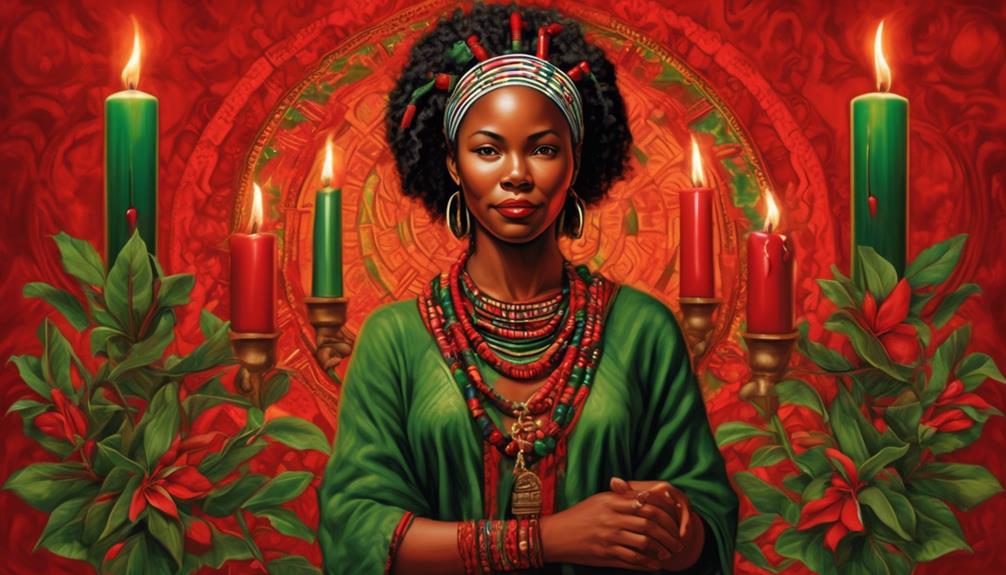
Traditional Kwanzaa symbols and decorations add depth and meaning to the holiday celebrations in Alabama. Incorporating these traditional symbols into our Kwanzaa decor ideas allows us to honor the rich cultural heritage of the African-American community and create a festive atmosphere that resonates with the spirit of unity and gratitude that Kwanzaa represents.
To engage our audience, let's explore some popular Kwanzaa symbols and their significance:
| Symbol | Meaning |
|---|---|
| Kinara | Represents the ancestral roots of African Americans and holds seven candles, each representing one of the Seven Principles of Kwanzaa. |
| Mkeka | A woven mat that symbolizes the foundation of African heritage and tradition. It serves as a reminder to always remember and honor our roots. |
| Mazao | Fruits and vegetables symbolize the harvest and the bounty of the earth. They remind us of the importance of collective work and the rewards it brings. |
| Kikombe cha Umoja | The Unity Cup, used during the Kwanzaa ceremony, represents the principle of unity and encourages participants to foster togetherness and collaboration. |
Incorporating these symbols into our Kwanzaa decorations helps create a meaningful and visually appealing ambiance. By embracing the traditions of Kwanzaa, we can celebrate our heritage and inspire a sense of unity and purpose within our community.
Incorporating Southern Themes Into Kwanzaa Decor
As we explore the rich cultural traditions of Kwanzaa in Alabama, it's fascinating to consider how incorporating Southern themes into our Kwanzaa decorations can further enhance the festive atmosphere and honor the diverse heritage of the African-American community.
One way to incorporate Southern themes into our Kwanzaa decor is through the use of southern-inspired Kwanzaa recipes. Alabama's history and heritage can be celebrated by preparing dishes that reflect the region's culinary traditions. For example, serving dishes like collard greens, black-eyed peas, and cornbread can pay homage to the agricultural roots of the South and the importance of community and family that Kwanzaa represents.
Another way to incorporate Alabama's history and heritage into Kwanzaa celebrations is through the use of traditional craft and artwork. By displaying handmade quilts, pottery, or paintings that draw inspiration from African-American artists in the South, we can create a visual representation of the intersection between Southern culture and African traditions. These artistic elements not only add beauty to our decorations but also serve as a reminder of the resilience and creativity of the African-American community in Alabama.
Incorporating Southern themes into our Kwanzaa decorations allows us to connect with our roots and celebrate the unique blend of African and Southern influences that make up our cultural identity. By embracing these traditions, we can create a warm and inviting atmosphere that reflects the spirit of Kwanzaa and the rich tapestry of our heritage.
A Look at Alabama's Unique Kwanzaa Traditions
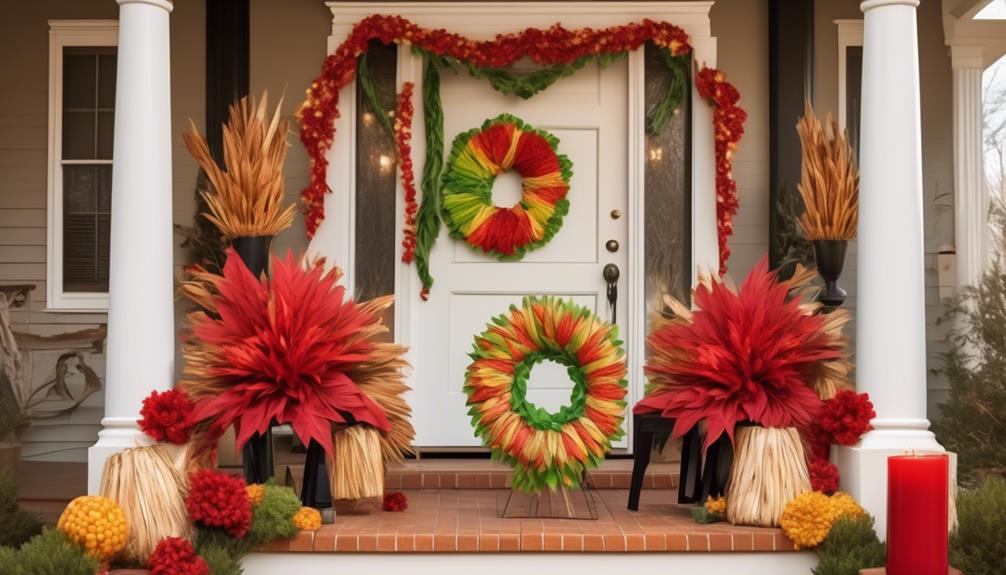
Alabama's unique Kwanzaa traditions reflect the vibrant cultural tapestry of the state's African-American community. Alabama Kwanzaa celebrations are deeply rooted in the principles and values of this week-long holiday. Families and communities come together to honor their African heritage and celebrate their shared values.
One of the distinctive aspects of Alabama's Kwanzaa traditions is the blending of African and Southern influences. Many families incorporate traditional African rituals and customs into their celebrations, while also incorporating elements of Southern culture. This fusion creates a unique and rich experience that's specific to Alabama.
During Kwanzaa, Alabamians gather for feasts where traditional African dishes are served alongside Southern favorites. The menu often includes soul food classics like collard greens, cornbread, and fried chicken, as well as African dishes such as jollof rice and plantains. The combination of flavors and culinary traditions creates a delicious and meaningful experience.
Another notable tradition in Alabama is the inclusion of African dance and music during Kwanzaa celebrations. African drumming, dancing, and singing are integral parts of the festivities, adding an energetic and joyful atmosphere. These performances not only entertain, but also serve as a way to honor African heritage and connect with ancestors.
In addition to these unique traditions, Alabama's Kwanzaa celebrations also encompass the core principles of the holiday: unity, self-determination, collective work and responsibility, cooperative economics, purpose, creativity, and faith. These principles guide the celebrations and serve as a reminder of the importance of community and cultural identity.
Colorful Kwanzaa Centerpiece Ideas
Colorful centerpieces are a vibrant and eye-catching addition to any Kwanzaa celebration. When it comes to creating a centerpiece for this joyous occasion, incorporating southern themes can add a unique touch. One idea is to use a mason jar filled with colorful flowers that represent the colors of Kwanzaa – red, green, and black. You can arrange the flowers in a way that creates a visually appealing display, with each color standing out and complementing the others.
Another idea is to use a rustic wooden crate as the base of your centerpiece. Fill it with an assortment of fruits like oranges, apples, and pomegranates, which not only add a burst of color but also symbolize the harvest season. You can also incorporate elements like magnolia leaves or cotton branches to give it a southern flair.
For a more elegant centerpiece, consider using a glass bowl filled with floating candles and colorful beads. The candles can be in the colors of Kwanzaa, and the beads can be chosen to match or contrast with them. This simple yet stunning centerpiece will create a warm and inviting ambiance for your Kwanzaa celebration.
Incorporating southern themes into your Kwanzaa centerpiece adds a personal touch and pays homage to the rich heritage of the region. Whether you choose flowers, fruits, or candles, these colorful centerpiece ideas will surely enhance the festive spirit of your Kwanzaa celebration.
DIY Kwanzaa Wreaths With a Southern Twist
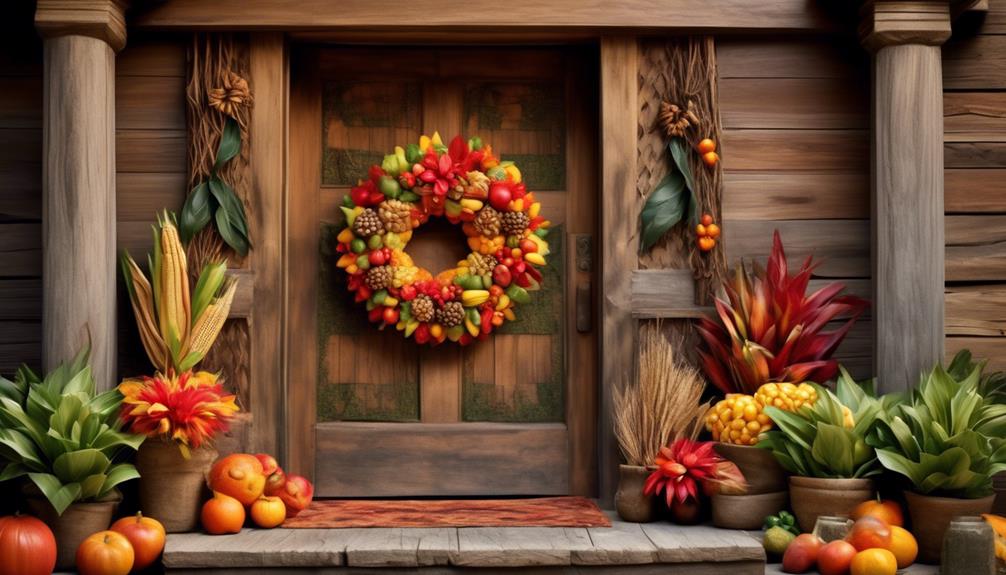
To continue our exploration of Kwanzaa decorations with a touch of southern charm, let's now turn our attention to crafting DIY Kwanzaa wreaths. These wreaths are a perfect way to add a festive touch to your home during the holiday season, while also embracing the unique traditions of Alabama.
When it comes to creating southern-themed Kwanzaa wreaths, the possibilities are endless. You can incorporate traditional Kwanzaa symbols, such as the kinara (candle holder), into your wreath design. Consider using materials like magnolia leaves, cotton bolls, or even mini horseshoes to give your wreath that unmistakable southern flair.
To help you get started, here are three ideas for DIY Kwanzaa wreaths with a southern twist:
| Wreath Idea | Materials Needed | Instructions |
|---|---|---|
| Magnolia Leaf Wreath | Magnolia leaves, floral wire, ribbon | 1. Gather a bunch of magnolia leaves. 2. Attach the leaves to a wreath form using floral wire. 3. Add a festive bow with ribbon. |
| Cotton Boll Wreath | Grapevine wreath, cotton bolls, hot glue gun | 1. Attach cotton bolls to the grapevine wreath using a hot glue gun. 2. Continue until the entire wreath is covered. |
| Horseshoe Wreath | Miniature horseshoes, wire wreath form, floral wire | 1. Wrap the wire wreath form with floral wire. 2. Attach the miniature horseshoes to the wreath using floral wire. 3. Hang and enjoy! |
These DIY Kwanzaa wreaths with a southern twist not only showcase your creativity, but also honor the rich heritage and traditions of Alabama. So gather your materials and let your imagination run wild as you create a wreath that embodies the spirit of Kwanzaa with a touch of southern charm.
Alabama's Love for Kente Cloth in Kwanzaa Decor
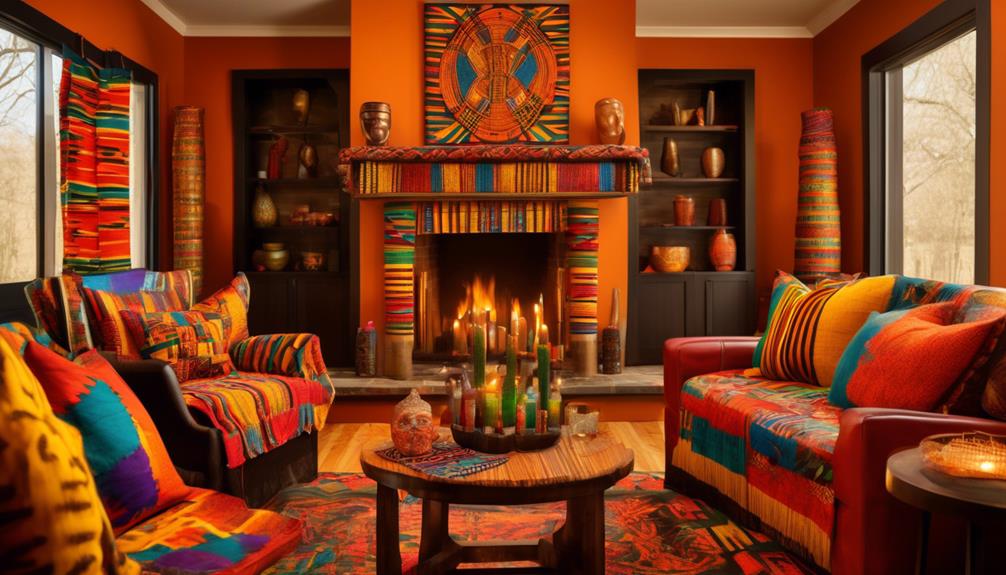
Kente cloth holds a special place in the hearts of many Alabamians when it comes to Kwanzaa decor. Its vibrant colors and intricate patterns add a touch of tradition and cultural significance to the celebrations. The history of kente cloth dates back centuries and originates from the Ashanti people in Ghana.
In Alabama, the cultural significance of kente cloth in Kwanzaa decor is deeply rooted in the state's history of African American heritage and the ongoing struggle for racial equality. The use of kente cloth in Kwanzaa decor is a way for Alabamians to embrace and celebrate their African roots. It serves as a visual representation of their identity and connection to their ancestors.
The cloth is often used to make tablecloths, banners, and even clothing during Kwanzaa celebrations in Alabama. In addition to its cultural significance, kente cloth also adds a sense of warmth and beauty to the Kwanzaa decorations. The vibrant colors and intricate patterns create a visually stunning display that enhances the celebratory spirit of the holiday.
Southern-inspired Kwanzaa Table Settings
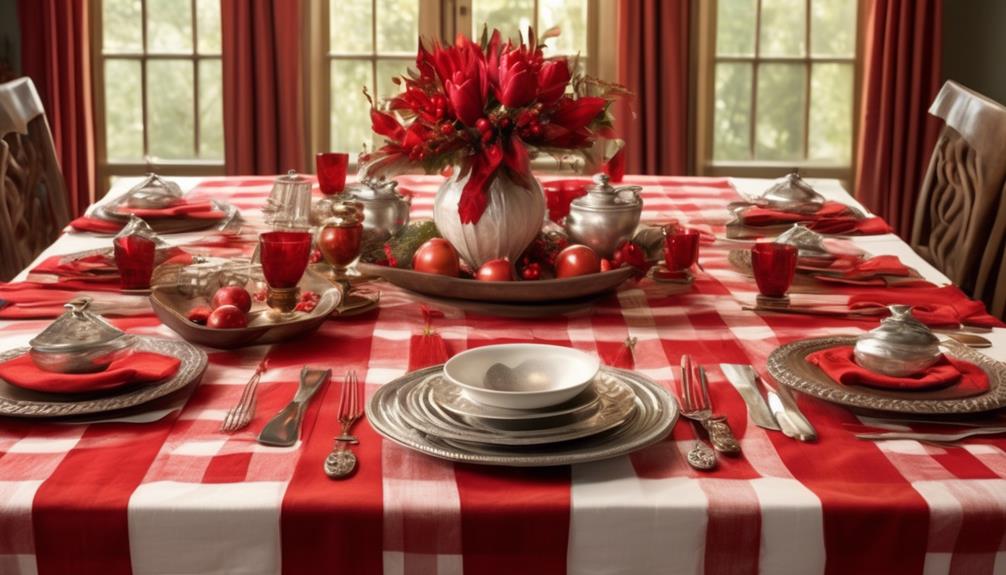
When it comes to Southern-inspired Kwanzaa table settings, we can expect a traditional flair that incorporates the rich culture of Alabama.
From elegant china adorned with magnolia blossoms to rustic wooden chargers engraved with meaningful symbols, the table settings reflect the charm and hospitality of the South.
These carefully curated arrangements pay homage to the traditions of Kwanzaa while adding a touch of southern warmth and style to the celebration.
Traditional Southern Flair
With a touch of traditional Southern flair, the Kwanzaa table setting exudes a unique charm that captures the spirit of the holiday. The combination of Southern-inspired decor and traditional elements creates a warm and inviting atmosphere that invites guests to gather and celebrate.
At the center of the table, a beautiful floral arrangement showcases vibrant blooms in hues of red, orange, and yellow, reminiscent of the Alabama sunset. To add a touch of elegance, delicate lace doilies adorn each place setting, providing a contrast against the rustic wooden table.
The table is set with fine china, passed down through generations, adding a sense of history and tradition to the celebration. Each place is marked with a personalized place card, carefully calligraphed in flowing cursive script.
As we gather around the table, the combination of these Southern touches creates a sense of nostalgia and warmth, reminding us of the rich heritage and celebratory spirit that permeates Alabama Kwanzaa festivities.
|  |  |
|---|---|
| Fine China | Personalized Place Cards |
Incorporating Alabama's Culture
Incorporating the vibrant culture of Alabama, the Southern-inspired Kwanzaa table settings capture the essence of tradition and celebration. Alabama's cultural influences, deeply rooted in Southern heritage, add a unique touch to the Kwanzaa festivities.
The table is adorned with items that reflect the rich history and customs of the state, such as handmade quilts in vibrant patterns, rustic wooden bowls filled with fresh fruits, and delicate porcelain plates featuring traditional Southern motifs. These elements not only enhance the visual appeal of the table, but also serve as a reminder of the importance of community, family, and unity – key principles celebrated during Kwanzaa.
The combination of Alabama's cultural influences and the spirit of Kwanzaa creates a warm and inviting atmosphere, inviting guests to come together and rejoice in the values that make Alabama and the South so unique.
Light up Your Kwanzaa With Alabama's Luminaries

Celebrate the spirit of Kwanzaa in Alabama by illuminating your festivities with the vibrant glow of traditional luminaries. These beautiful and symbolic decorations won't only add a touch of Southern charm to your celebrations but also create a warm and inviting ambiance for your family and friends.
Here are three reasons why incorporating Alabama's luminaries will make your Kwanzaa celebration truly special:
- Symbolic Representation: Luminaries hold deep symbolism in Kwanzaa celebrations. As the candles inside them flicker and dance, they represent the principles of Kwanzaa, such as unity, self-determination, and purpose. The soft glow emanating from these luminaries creates a serene atmosphere, encouraging reflection and connection with loved ones.
- Authentic Southern Heritage: Alabama is known for its rich cultural heritage, and incorporating traditional luminaries into your Kwanzaa decorations is a beautiful way to honor this heritage. These luminaries, often made from brown paper bags or white paper lanterns, have been used for centuries in the South to celebrate important occasions. By including them in your Kwanzaa decor, you're paying homage to the traditions and history of the region.
- Warm and Welcoming Atmosphere: The soft, warm glow of luminaries instantly creates a cozy and welcoming atmosphere. As you gather with your loved ones to celebrate Kwanzaa, the gentle flicker of these lights will create a sense of peace and tranquility. Whether you place them along your walkway, on your porch, or as a centerpiece on your dining table, the luminaries will infuse your celebrations with a touch of magic and warmth.
Incorporating Alabama's luminaries into your Kwanzaa decorations not only adds a unique Southern flair but also creates a captivating and intimate ambiance for your festivities. Let the glow of these traditional luminaries light up your Kwanzaa celebrations in Alabama.
Homemade Kwanzaa Ornaments With a Southern Flair

As we continue exploring the vibrant world of Kwanzaa celebrations in Alabama, let's now turn our attention to the artistry of crafting homemade Kwanzaa ornaments with a distinct Southern flair. The fusion of African traditions and local Alabama customs creates a unique and meaningful experience for Kwanzaa celebrants in the state.
To infuse a Southern touch into Kwanzaa ornaments, Alabamians incorporate their rich heritage and local traditions. Here is a table showcasing some southern themed Kwanzaa crafts that integrate Alabama's cultural elements:
| Ornament | Southern Flair |
|---|---|
| Sweet Potato | A representation of the beloved Southern staple |
| Cotton Boll | Symbolizes Alabama's historic connection to cotton |
| Magnolia Leaf | Represents the state flower and its beauty |
| Fleur-de-lis | Pays homage to Alabama's French colonial roots |
| Jazz Musicians | Celebrates the state's vibrant jazz music scene |
These ornaments not only add a Southern touch to the Kwanzaa celebrations but also serve as a reminder of the rich cultural heritage of Alabama. By incorporating local Alabama traditions into their crafts, Kwanzaa celebrants in the state create a unique and authentic experience that celebrates both their African roots and their Southern identity.
Crafting homemade Kwanzaa ornaments with a Southern flair allows Alabamians to express their creativity while honoring their heritage. It is a testament to the inclusive and celebratory spirit of Kwanzaa, where traditions are adapted and embraced in meaningful ways.
Kwanzaa Candle Lighting Ceremony in Alabama
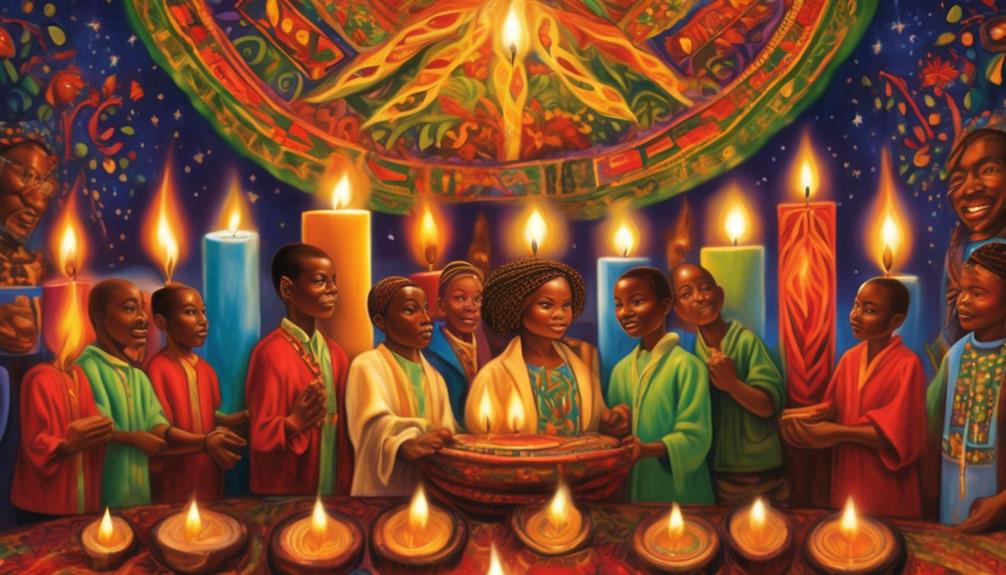
As we explore the topic of the Kwanzaa Candle Lighting Ceremony in Alabama, we can begin by understanding the meaning behind the Kwanzaa candles and their symbolism.
The candle lighting ceremony holds great significance in celebrating the seven principles of Kwanzaa, known as the Nguzo Saba. Each candle represents one principle and is lit on its corresponding day during the week-long celebration.
Traditionally, the candles are arranged in a special candleholder called the kinara, which holds three red, three green, and one black candle.
Meaning of Kwanzaa Candles
During the Kwanzaa candle lighting ceremony in Alabama, the flickering flames of the candles illuminate the rich symbolism and profound meaning behind each one. The candles play a significant role in honoring African heritage and promoting unity among the community.
- The Black Candle: Representing unity, this central candle is lit on the first day of Kwanzaa. It symbolizes the collective strength of the African American community, reminding us of the importance of coming together as one.
- The Red Candles: These candles stand for the struggles and sacrifices made by our ancestors. They serve as a reminder of the bloodshed and resilience that has shaped our history.
- The Green Candles: Symbolizing hope and growth, these candles represent the future and the aspirations we hold. They remind us to strive for a better tomorrow and to support each other in achieving our goals.
As the candles are lit one by one, their warm glow fills the room, fostering a sense of togetherness and inspiring reflection on the values that Kwanzaa represents.
Symbolism in Candle Lighting
The symbolism of the candle lighting ceremony during the Kwanzaa celebration in Alabama is rich with meaning and serves as a powerful reminder of the values and principles that unite the community. Each candle represents one of the seven principles of Kwanzaa, known as the Nguzo Saba, which guide people in their daily lives. The lighting of the candles is a symbolic act of bringing light and knowledge into the darkness, and signifies the importance of passing down cultural traditions and values to future generations. The candles are arranged in a special kinara, or candleholder, which has three red candles on the left, three green candles on the right, and one black candle in the center. This arrangement symbolizes the African American flag, with the red representing the struggles of the past, the green symbolizing hope for the future, and the black representing the people and their unity. The candle lighting ceremony is a deeply meaningful tradition that reinforces the cultural significance of Kwanzaa in Alabama.
| Candle Color | Meaning |
|---|---|
| Red | Struggle and sacrifice |
| Green | Hope and growth |
| Black | Unity and pride |
Note: The table above represents the symbolism of the candle colors in the Kwanzaa candle lighting ceremony.
Traditional Candle Arrangement
Continuing from the symbolism of the candle lighting ceremony, the traditional arrangement of the candles in the Kwanzaa celebration in Alabama holds significant cultural meaning. The candle arrangement consists of seven candles, each representing one of the seven principles of Kwanzaa.
Here is a closer look at the traditional candle arrangement, incorporating southern themes:
- Unity (Umoja): The black candle, placed in the center, represents the unity of the African American community in Alabama.
- Self-Determination (Kujichagulia): To the left of the black candle, the red candle symbolizes the struggle for self-determination and empowerment.
- Collective Work and Responsibility (Ujima): On the right of the black candle, the green candle signifies the collective efforts of the community to work together and uplift one another.
The arrangement of these candles not only illuminates the room but also serves as a reminder of the core values and principles that Kwanzaa represents. It's a beautiful sight that brings warmth and meaning to the Kwanzaa celebration in Alabama.
Alabama's Kwanzaa Music and Dance Traditions
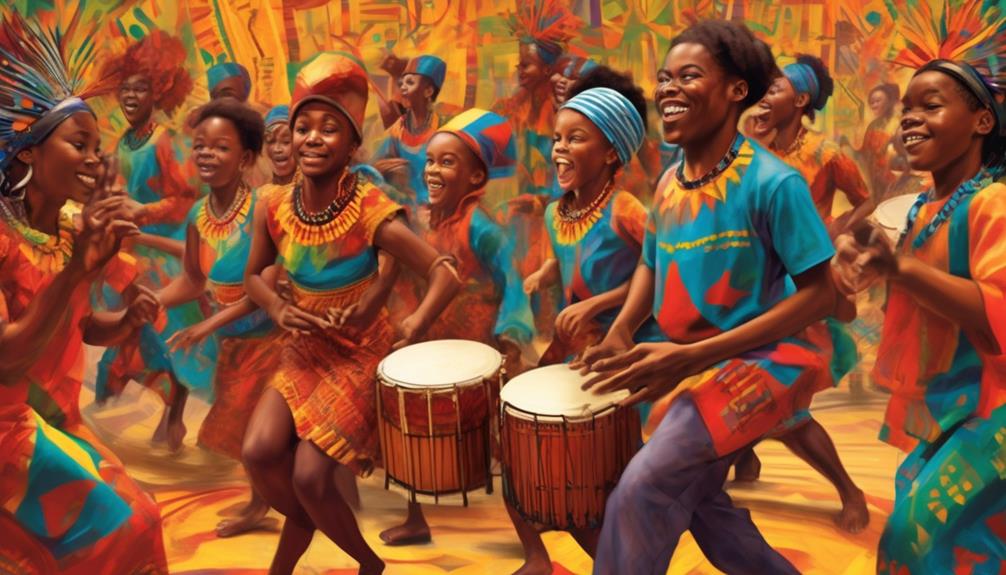
Immersed in the rich cultural heritage of Alabama, Kwanzaa celebrations come alive with vibrant music and captivating dance traditions. Alabama's Kwanzaa music and dance traditions are a reflection of the state's unique Kwanzaa traditions. The music is a blend of African rhythms, soulful melodies, and the sounds of the Deep South. It fills the air with an infectious energy, inviting everyone to join in the celebration.
The beats of drums, the strumming of guitars, and the soulful voices of singers create a melodic tapestry that sets the tone for the festivities. The music is both joyful and reflective, echoing the principles of Kwanzaa – unity, self-determination, collective work, and responsibility, cooperative economics, purpose, creativity, and faith.
As the music fills the air, dancers take to the floor, showcasing their skills and expressing the spirit of Kwanzaa through movement. Alabama's Kwanzaa dance traditions are a fusion of African dance styles and contemporary choreography. The dancers move with grace and precision, their bodies telling stories of resilience, community, and cultural pride.
Watching the dancers, one can't help but be captivated by their fluid movements and the passion they bring to the celebration. The dance traditions not only entertain but also serve as a powerful reminder of the importance of cultural heritage and the values that Kwanzaa represents.
In Alabama, Kwanzaa isn't just a holiday but a vibrant and dynamic celebration of African-American culture. It's a time to come together, to honor the past, and to embrace the future. The music and dance traditions of Alabama's Kwanzaa celebrations are an integral part of this celebration, adding an extra layer of joy and unity to the festivities.
Sharing the Joy of Kwanzaa in Alabama Communities
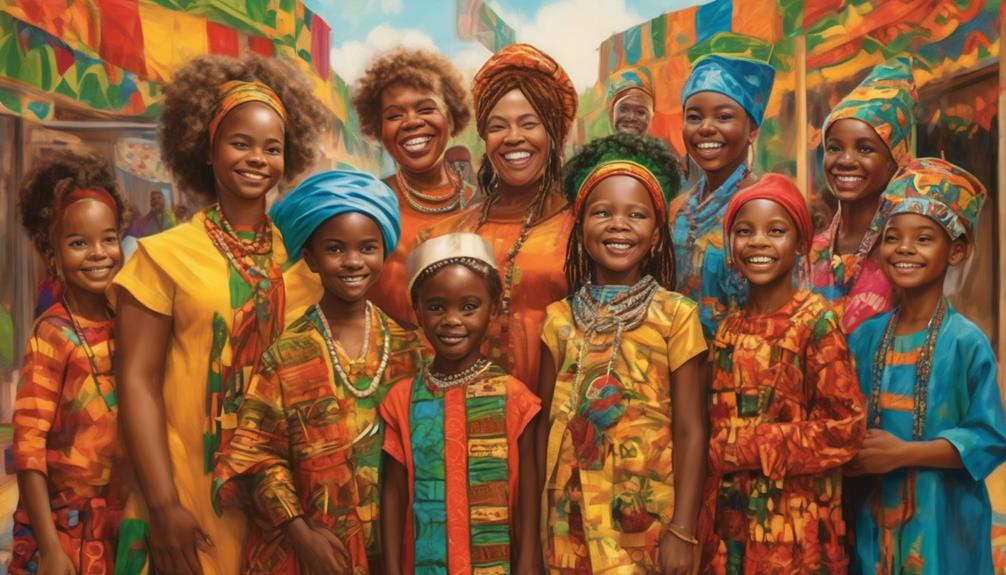
In Alabama communities, the joy of Kwanzaa is shared through vibrant celebrations and cultural gatherings. It's a time when families and friends come together to honor African heritage and values.
Here is a glimpse into the Alabama Kwanzaa celebrations:
- Community Gatherings:
Alabama communities organize Kwanzaa events that bring people from different backgrounds together. These gatherings foster a sense of unity and solidarity, creating a warm and welcoming atmosphere for all attendees.
- Traditional Rituals:
During Kwanzaa, people in Alabama engage in various rituals that symbolize the seven principles of the holiday. Lighting the kinara, sharing the unity cup, and exchanging handmade gifts are some of the cherished traditions that highlight the importance of unity, self-determination, and collective responsibility.
- Kwanzaa-Inspired Crafts:
Alabama residents showcase their creativity by making Kwanzaa-inspired crafts. From beautiful homemade kinara candle holders to colorful African-inspired decorations, these crafts add a personal touch to the celebrations and serve as a reminder of the rich African heritage.
In Alabama, the joy of Kwanzaa isn't limited to one particular community but is embraced by people from all walks of life. It's a time of reflection, appreciation, and celebration of African culture, bringing Alabama communities closer together.
Frequently Asked Questions
What Are the Traditional Symbols and Decorations Used During Kwanzaa?
Traditional symbols and decorations of Kwanzaa play a significant role in celebrating this African-American holiday. These include the Kinara (candle holder) with seven candles representing the Seven Principles of Kwanzaa, the Mkeka (mat) symbolizing the foundation of African heritage, and the Kikombe cha Umoja (unity cup) emphasizing unity and collective responsibility.
Incorporating southern themes into Kwanzaa decorations can add a unique touch, blending the celebratory spirit of the holiday with the rich heritage of the South.
How Can Southern Themes Be Incorporated Into Kwanzaa Decorations?
Incorporating southern themes into Kwanzaa decorations allows us to celebrate our diverse heritage in a unique and meaningful way.
By using symbols and colors that are significant to the southern culture, such as magnolias, cotton, and vibrant hues reminiscent of the region's landscape, we can create a beautiful fusion of traditions.
These decorations not only honor our southern roots but also serve as a reminder of the rich history and celebratory spirit that exists within our community.
What Are Some Unique Kwanzaa Traditions Specific to Alabama?
When it comes to Alabama Kwanzaa traditions, there are several unique practices that make the celebrations in this state special.
From vibrant community gatherings to soulful performances of traditional African music and dance, Alabama Kwanzaa celebrations truly embody the spirit of unity and cultural pride.
Additionally, many families in Alabama incorporate local flavors into their Kwanzaa feasts, infusing traditional dishes with a Southern twist.
These traditions showcase the rich heritage and celebratory spirit of Alabama during this joyous holiday.
What Are Some Ideas for Colorful Kwanzaa Centerpieces?
When it comes to colorful Kwanzaa centerpieces, there are a few ideas that come to mind.
One option is to create vibrant fruit arrangements using a variety of fruits like oranges, bananas, and grapes. These arrangements not only add a pop of color to your table but also symbolize the harvest and abundance associated with Kwanzaa.
Another idea is to make DIY candle holders using colorful glass jars or mason jars. This adds a warm and festive touch to your centerpiece while incorporating the traditional lighting of the Kwanzaa candles.
How Can Kwanzaa Wreaths Be Made With a Southern Twist?
When it comes to DIY Kwanzaa wreaths, adding a southern twist can bring a unique charm to the celebrations. We can create southern inspired wreaths by incorporating elements like magnolia leaves, cotton branches, and vibrant ribbons.
These wreaths can reflect the rich heritage of the South while honoring the principles of Kwanzaa. By combining the celebratory spirit of Kwanzaa with the warmth and beauty of southern decor, we can create wreaths that are both meaningful and visually stunning.
How Do Kwanzaa Decorations Reflect the Local Culture and Traditions in Different States?
Kwanzaa decorations in Hawaii are known for incorporating the aloha spirit, with a unique blend of traditional African symbols and local Hawaiian elements. Each state showcases its cultural diversity through diverse ornaments and colors, reflecting the rich tapestry of local traditions and heritage.
Conclusion
In Alabama, Kwanzaa brings together the rich heritage of the South with the celebratory spirit of this African American holiday. Traditional symbols and decorations are infused with Southern themes, creating a unique and vibrant atmosphere. From colorful centerpieces to homemade ornaments, Alabama's Kwanzaa traditions reflect a deep sense of community and joy.
The candle lighting ceremony, accompanied by music and dance, further enhances the spirit of togetherness. Through these traditions, Alabama communities share the joy and significance of Kwanzaa with one another, creating a tapestry of cultural celebration.
- About the Author
- Latest Posts
Introducing Ron, the home decor aficionado at ByRetreat, whose passion for creating beautiful and inviting spaces is at the heart of his work. With his deep knowledge of home decor and his innate sense of style, Ron brings a wealth of expertise and a keen eye for detail to the ByRetreat team.
Ron’s love for home decor goes beyond aesthetics; he understands that our surroundings play a significant role in our overall well-being and productivity. With this in mind, Ron is dedicated to transforming remote workspaces into havens of comfort, functionality, and beauty.
Architecture Home Styles
5 Key Differences Between American and European Houses
A fascinating comparison between American and European houses reveals surprising differences that shape how we live – discover more within!

As the saying goes, 'a man's home is his castle,' but have you ever wondered how American and European houses differ?
From size and layout to materials and energy efficiency, these two continents have their distinct approaches to home construction.
The differences go beyond just aesthetics, influencing how people live and interact within their homes.
Understanding these variations can provide valuable insights into the cultural and societal norms that shape our living spaces.
Key Takeaways
- American homes are larger with open layouts, while European homes are more compact with separate rooms.
- European homes focus on energy efficiency with strict regulations and use of materials like stone and concrete.
- American homes prioritize personalized decor with a mix of styles, while European homes lean towards timeless and elegant furniture.
- European governments enforce energy efficiency laws, while American homes lack strict regulations and lag behind in efficiency measures.
Size Disparities
When comparing American and European houses, the most striking difference lies in their size disparities. U.S. statistics reveal a significant trend towards larger homes in America, with houses, condos, and apartments offering considerably more square footage than their European counterparts. This size gap is particularly evident in the abundance of outdoor spaces and areas for family activities that American properties tend to feature, reflecting a cultural emphasis on spacious living environments.
European homes, on the other hand, are often more compact, showcasing a different set of living preferences and spatial considerations. The smaller size of European homes can be attributed to various factors, such as historical architectural norms, urban density, and a focus on efficient use of space. These differences in size and layout highlight the diverse approaches to housing design and lifestyle choices between the two regions.
As the housing market continues to evolve, understanding these distinctions can offer valuable insights for innovation and future developments in the industry.
Layout Variances
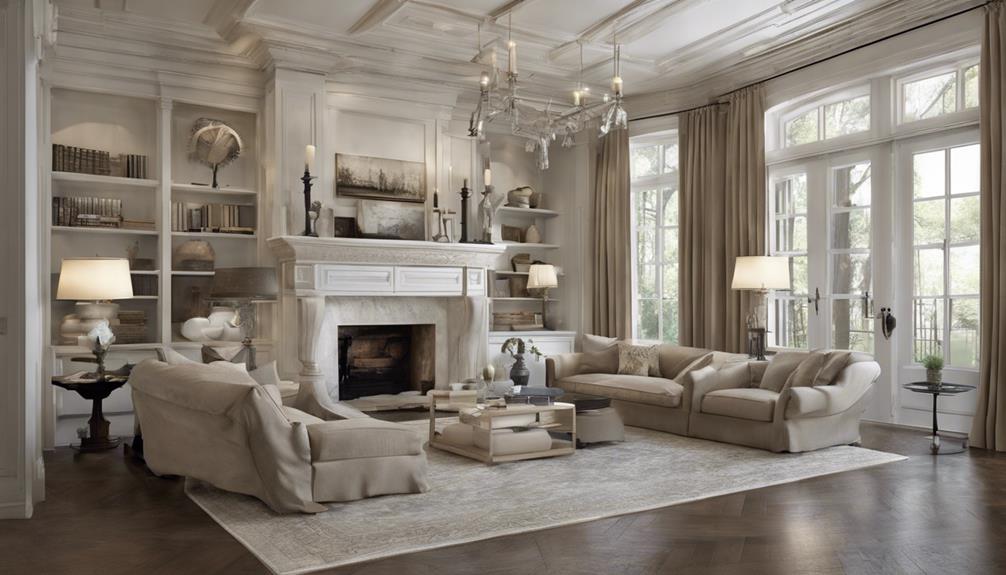
The size disparities between American and European houses extend to their layout variances, showcasing distinct approaches to spatial design and functionality in residential properties. American homes typically embrace open and spacious layouts, emphasizing larger shared spaces like living rooms, kitchens, and dining areas. In contrast, European homes favor a more compact and cozy feel by having smaller, separate rooms for different functions.
Another key difference lies in the bedroom and bathroom count, with American homes generally boasting more of each compared to their European counterparts. This variance caters to accommodating larger families or frequent guests in American households. Furthermore, European homes often feature freestanding wardrobes for storage solutions, while American homes tend to prioritize larger built-in closets for organization purposes.
These layout disparities between American and European homes not only speak to differences in spatial preferences but also reflect distinct cultural inclinations towards space utilization and living arrangements. The innovative designs in both regions cater to unique lifestyle demands and aesthetic sensibilities, shaping the residential experiences of their inhabitants.
Material Preferences
Taking into account the material preferences in American and European homes, it becomes evident that distinct choices in construction elements significantly shape the aesthetic and functional aspects of residential properties on both continents. European homes commonly feature stone walls and wood roofs for insulation, while American homes lean towards shingle roofs and brick walls. Both regions utilize granite worktops in kitchens, but Europeans tend to prefer stone or marble flooring, while Americans often opt for tiles.
Natural wooden flooring is a prevalent choice in homes on both continents, highlighting a mutual appreciation for this material. Moreover, European homes typically incorporate thicker walls to enhance temperature regulation and soundproofing, a contrast to American homes' construction methods. Additionally, European houses often prioritize energy-efficient windows with thick frames and glass, whereas American homes may not emphasize this feature as significantly.
- Stone walls and wood roofs vs. Shingle roofs and brick walls
- Stone or marble flooring vs. Tile flooring
- Thicker walls for temperature regulation and soundproofing
- Emphasis on energy-efficient windows in European homes
Energy Efficiency Contrasts
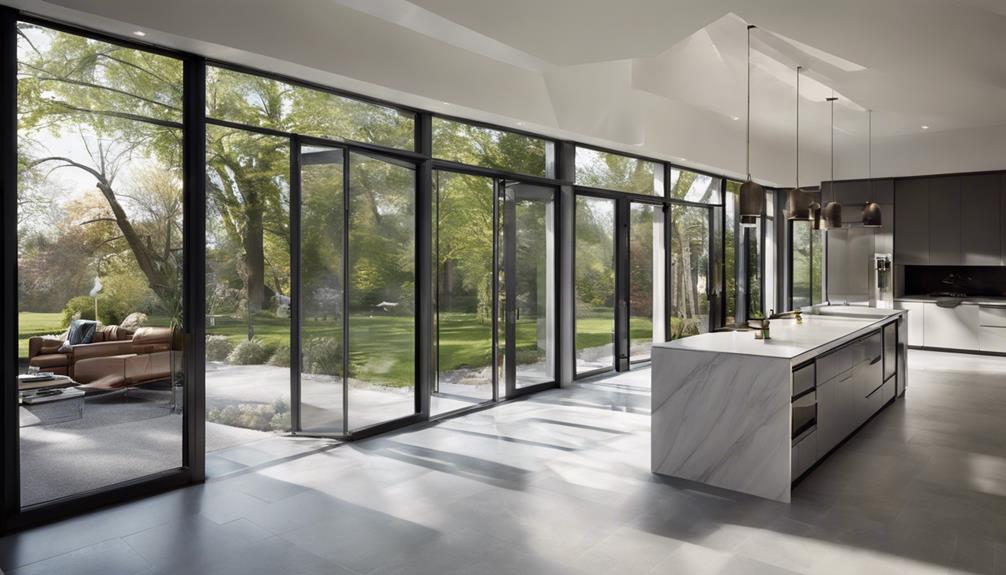
Comparing energy efficiency standards between American and European homes reveals stark contrasts in prioritization and implementation strategies. European homes lead the way in energy efficiency, emphasizing strict regulations and maximum insulation standards. This focus results in lower energy costs for heating and cooling in European homes compared to their American counterparts.
The materials commonly used in European homes, such as stone, brick, and concrete, contribute to better heating and cooling efficiency. European governments play a significant role in enforcing laws that promote energy efficiency in residential buildings, creating a culture that values sustainable living. Additionally, the widespread utilization of solar energy for water heating in European homes showcases a proactive approach to reducing energy consumption.
In contrast, American homes have yet to fully embrace such stringent energy efficiency measures, leading to higher energy costs and a greater environmental impact. The divergence in energy efficiency practices between American and European homes highlights the importance of prioritizing sustainability in residential construction.
Aesthetic Styles
Emphasizing comfort and functionality, American homes often feature modern and cozy furniture styles. In contrast, European homes typically showcase traditional, wooden, and heavier furniture pieces for a more classic and elegant aesthetic. The differences in aesthetic styles between American and European homes aren't just about furniture; they reflect cultural preferences and design influences that have evolved over time.
- American homes:
- Mix and match decor styles to create personalized and inviting spaces.
- Incorporate modern furniture pieces for a contemporary look.
- Focus on coziness and functionality in furniture choices.
- Embrace a variety of design influences to stay innovative and fresh.
The European aesthetic:
- Prioritizes simplicity and tradition in decor.
- Prefers timeless pieces that exude elegance.
- Showcases a more formal and structured approach to interior design.
- Draws inspiration from rich cultural heritage for a refined look.
Frequently Asked Questions
What Is the Difference Between American and European Houses?
When comparing American and European houses, it's evident that they exhibit distinct characteristics. American homes tend to be more spacious, with larger layouts and built-in closets, emphasizing open living areas.
On the other hand, European homes are known for their compact design, energy efficiency, and traditional aesthetic. These differences in size, storage solutions, and architectural styles showcase the unique approaches to housing in different regions.
What Is the Difference Between American Design and European Design?
When looking at American and European design, we notice distinct contrasts. American design often embraces open layouts and modern aesthetics, while European design tends towards cozier, traditional elements.
These differences extend to furniture choices, with American homes favoring built-in closets for storage, in contrast to European homes' freestanding wardrobes.
Additionally, American homes typically offer more bedrooms and bathrooms, providing ample personal space compared to European counterparts.
What Are the Characteristics of a European House?
European houses typically emphasize energy efficiency and sustainable design. They utilize materials like stone, wood, and concrete for insulation. They often feature smaller dimensions with a focus on quality over quantity.
Interestingly, 90% of new homes in Europe are built with energy efficiency in mind, showcasing a commitment to environmentally friendly practices. This dedication to sustainable living sets European homes apart in the global housing market.
What Do Houses Look Like in Europe?
Houses in Europe vary in style and design, showcasing a blend of traditional elements and modern innovations. From cozy cottages to sleek urban apartments, European homes often prioritize energy efficiency and sustainability.
Features like stone walls, wooden roofs, granite worktops, and natural flooring are common. With smaller footprints compared to American houses, European homes are designed to maximize space and functionality while incorporating timeless aesthetics.
Conclusion
In conclusion, the differences between American and European houses go beyond just architectural styles – they reflect unique cultural values and priorities.
For example, a study comparing energy consumption in homes across the two continents found that European homes, with their focus on energy efficiency and smaller dimensions, consumed significantly less energy on average than their American counterparts.
This highlights the impact of design and construction choices on sustainability and resource conservation in the built environment.
- About the Author
- Latest Posts
Introducing Ron, the home decor aficionado at ByRetreat, whose passion for creating beautiful and inviting spaces is at the heart of his work. With his deep knowledge of home decor and his innate sense of style, Ron brings a wealth of expertise and a keen eye for detail to the ByRetreat team.
Ron’s love for home decor goes beyond aesthetics; he understands that our surroundings play a significant role in our overall well-being and productivity. With this in mind, Ron is dedicated to transforming remote workspaces into havens of comfort, functionality, and beauty.
Architecture Home Styles
Exploring the Difference Between Modern and Classic Home Decor
Kickstart your journey into the contrasting worlds of modern and classic home decor to discover the unexpected twists that shape your ideal living space.
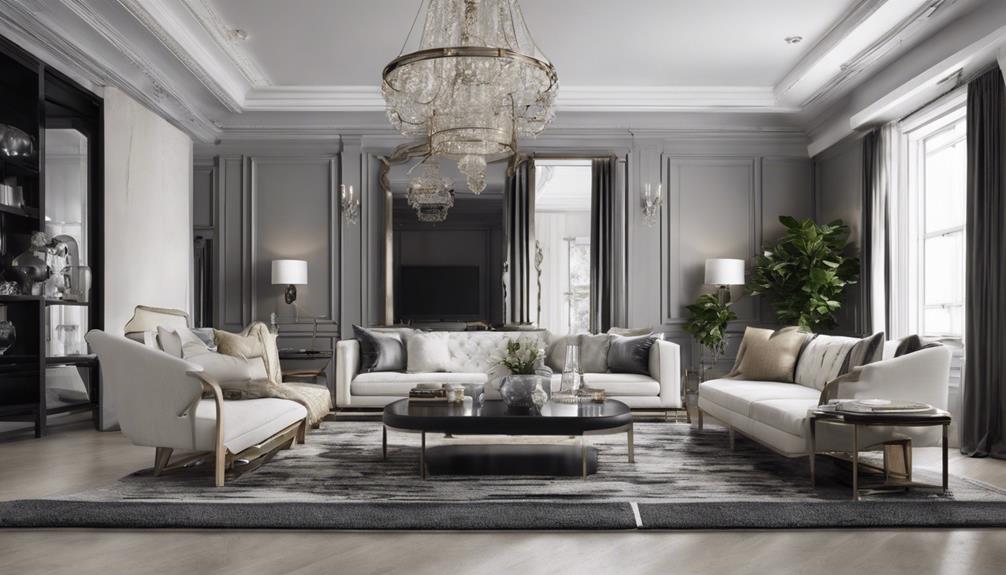
As we navigate the realm of home decor, the distinction between modern and classic styles stands as a fork in the design road, each path offering its own allure. One leads to the sleek, minimalist landscapes of modern design, while the other meanders through the intricate tapestries of classic elegance.
What sets these two apart in terms of ambiance and personal expression may surprise you. Let's unravel the layers of modern and classic home decor to uncover the secrets they hold for crafting your ideal living space.
Key Takeaways
- Modern home decor focuses on clean lines, minimalism, and technology integration.
- Classic home decor emphasizes ornate details, rich woods, and plush fabrics.
- Combining traditional warmth with modern simplicity creates a timeless and inviting space.
- Personalizing decor with unique elements like family mementos and customized color schemes enhances the home.
Characteristics of Modern Home Decor
Modern home decor, with its emphasis on clean lines, minimalistic furniture, and a focus on functionality, embodies a contemporary elegance that resonates with the desire for sleek, clutter-free living spaces. This design style deviates from the ornate and intricate detailing of Traditional interiors, opting instead for simplicity and sophistication.
In Modern design, furniture pieces are often sleek and geometric, contributing to a sense of openness and fluidity within a space. Neutral color palettes like whites, grays, and blacks dominate the Modern interior landscape, creating a canvas that allows for pops of color through decor and art. The integration of technology is a hallmark of Modern decor, with smart home features seamlessly blending into the overall design.
Sustainability is another key aspect, with eco-friendly materials and energy-efficient solutions being prioritized. Modern design celebrates open spaces, natural light, and a harmonious balance between form and function, making it a popular choice for those seeking a contemporary aesthetic.
Elements of Classic Home Decor
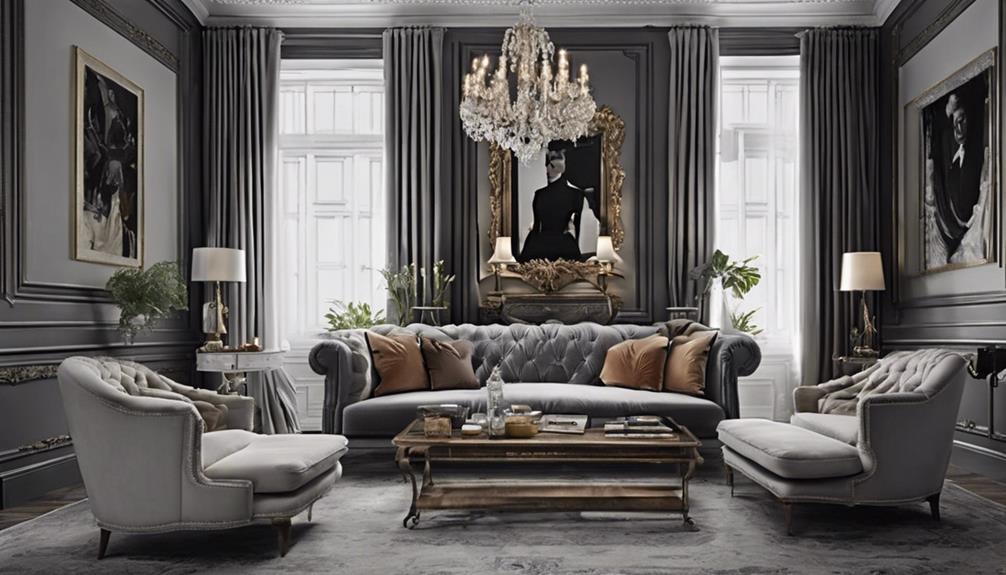
Embracing the essence of time-honored elegance and opulence, classic home decor showcases a distinct charm through its elaborate moldings, rich woods, and plush fabrics. Symmetrical patterns are meticulously incorporated to create a sense of order and attention to detail, enhancing the overall grandeur of the space. Heavy furniture pieces, often ornate and intricate, take center stage, prioritizing form over function in classic home decor. The warm color palette frequently used in this style cultivates a cozy and inviting atmosphere, enveloping visitors in a sense of comfort and nostalgia.
| Elements of Classic Home Decor | Description |
|---|---|
| Elaborate Moldings | Intricate and ornate trimmings that adorn walls and ceilings. |
| Rich Woods | Luxurious wooden furniture and fixtures adding warmth and elegance. |
| Plush Fabrics | Soft and lavish materials like velvet and silk for upholstery and drapery. |
| Symmetrical Patterns | Balanced designs that reflect a meticulous attention to detail and order. |
Design Influences on Home Decor
Transitioning from the intricate details of classic home decor, design influences on home decor encompass a broad spectrum of styles and trends that shape the way we create and personalize our living spaces.
Modern design, with its minimalist principles and emphasis on clean lines, influences contemporary styles by promoting simplicity and functionality. In contrast, traditional design draws inspiration from historical elements, showcasing ornate patterns and traditional finishes that evoke a sense of timeless elegance.
Interior design today often combines aspects of modern and classic decor to create unique spaces that reflect individual tastes. Modern furniture pieces are favored for their sleek designs and ability to complement various color schemes, while classic elements like rich colors and luxurious textures add depth and sophistication to a room.
Furthermore, the trend towards open spaces in modern design has influenced how we arrange furniture and envision our living areas, emphasizing a sense of flow and connectivity within the home. These design influences continually shape the way we perceive and interact with our living environments, offering a blend of tradition and innovation for a truly personalized aesthetic.
Incorporating Modern and Classic Styles

Incorporating a harmonious blend of modern and classic styles in home decor elevates the aesthetic appeal and creates a timeless charm that resonates with personal tastes and preferences. When merging traditional design elements with modern design concepts, one can achieve a truly unique and captivating interior.
Here are three key ways to seamlessly integrate traditional and modern styles:
- Blend Traditional Colors with Contemporary Interior: Combining classic color palettes and patterns with sleek, modern furniture can create a striking visual contrast that adds depth and character to the space.
- Integrate Vintage Pieces with Contemporary Furnishings: Mixing vintage or antique decor items with contemporary pieces brings a sense of history and character to a room, enhancing its overall appeal.
- Achieve a Balance Between Traditional and Modern Touch: Striking a balance between the warmth of traditional decor and the clean lines of modern design ensures a versatile and inviting atmosphere that's both stylish and functional.
Creating a Personalized Home Decor Style
Our home decor style becomes a reflection of our unique personality and preferences, shaping a space that is distinctly ours. Incorporating personal mementos, customizing color schemes, furniture arrangements, and mixing traditional with modern elements all play a crucial role in creating a personalized living space that speaks to who we are. By adding personal mementos, such as family photos or heirlooms, we infuse our decor with sentimental value and memories. Choosing the right color schemes and furniture arrangements allows us to express our style and create a harmonious atmosphere. Accessories like artwork or decorative pieces add a unique touch to the space. The table below showcases how mixing elements and expressing personality through decor choices can transform a house into a personalized and inviting home.
| Elements | Description | Emotion |
|---|---|---|
| Personal Mementos | Family photos, heirlooms | Sentimental |
| Color Schemes | Customized palettes | Vibrant |
| Furniture Arrangements | Unique layouts | Cozy |
| Accessories | Artwork, decorative pieces | Stylish |
| Mixing Elements | Traditional with modern | Eclectic |
Frequently Asked Questions
What Is the Difference Between Modern and Classic Home Decor?
When comparing modern and classic home decor, one can discern a stark contrast in design principles, color schemes, and overall ambiance.
Modern decor boasts clean lines, minimalism, and neutral hues for a sleek and uncluttered feel.
In contrast, classic decor showcases ornate details, rich colors, and traditional patterns, emanating warmth and elegance.
The distinction lies in the fusion of simplicity and functionality versus traditional elements and opulence.
How Do You Mix Modern and Classic Decor?
When mixing modern and classic decor, we emphasize blending traditional elements like ornate details and warm colors with modern aesthetics like clean lines and neutral tones.
This fusion creates a harmonious balance between old-world charm and sleek modernism, incorporating classic patterns and textiles to add depth.
A cohesive color scheme ties everything together, while statement pieces merging traditional craftsmanship with modern design serve as stunning focal points.
What Is the Difference Between Modern Design and Classic Design?
When we compare modern design to classic design, the distinction lies in their essence. Modern design embraces simplicity, clean lines, and minimalism, deriving inspiration from the early to mid-20th century.
In contrast, classic design showcases ornate details, rich colors, and traditional patterns, drawing from the opulence of Western European 18th-19th-century décor. The former prioritizes functionality and neutral hues, while the latter exudes historical richness and warmth.
What Is the Difference Between Contemporary and Traditional Decor?
Well, folks, when it comes to contemporary versus traditional decor, we've got two different worlds colliding!
Traditional decor is all about the ornate details, rich colors, and luxurious fabrics, giving off that classic and timeless vibe.
On the flip side, contemporary decor is all about simplicity, clean lines, and minimalism, showcasing the latest trends and innovative materials.
Conclusion
As we navigate the world of home decor, we're reminded that 'simplicity is the ultimate sophistication.'
Embracing the differences between modern and classic styles allows us to create a personalized space that reflects our unique tastes and preferences.
Whether we choose clean lines and muted colors or rich details and traditional patterns, our homes become a reflection of our personalities and a sanctuary where comfort meets style.
In the end, it's all about finding the perfect balance that brings us joy and serenity.
- About the Author
- Latest Posts
Introducing Ron, the home decor aficionado at ByRetreat, whose passion for creating beautiful and inviting spaces is at the heart of his work. With his deep knowledge of home decor and his innate sense of style, Ron brings a wealth of expertise and a keen eye for detail to the ByRetreat team.
Ron’s love for home decor goes beyond aesthetics; he understands that our surroundings play a significant role in our overall well-being and productivity. With this in mind, Ron is dedicated to transforming remote workspaces into havens of comfort, functionality, and beauty.
Carnival Decoration
Why Do You Need Magnets on a Cruise Ship?

As passionate cruisers, we are all too familiar with the challenge of keeping our daily schedules, important documents, and cabin keys organized and easily accessible while on board. That’s where magnets can be a lifesaver.
But have you ever stopped to consider the multitude of other reasons why magnets are a must-have on a cruise ship?
From personalizing your cabin walls to securing towels and clothing, the uses of magnets go far beyond just holding up a daily schedule.
Join us as we explore the numerous ways in which magnets can enhance your cruise experience and make your time at sea even more enjoyable.
Key Takeaways
- Magnets can be used to organize daily schedules and prioritize activities on a cruise ship.
- Magnetic storage solutions can help secure important documents and prevent their loss.
- Magnets can be strategically placed in cabins to keep important documents in a designated, secure location.
- Visual displays using magnets can enhance passengers' awareness, anticipation, and personalization of the cruise itinerary.
Organizing Daily Schedules

When organizing daily schedules on a cruise ship, it's essential to prioritize activities and events to ensure efficient use of time and optimal guest experience. Time management plays a pivotal role in creating a well-structured daily schedule. By carefully allocating time slots for various activities, such as onboard entertainment, dining, and shore excursions, guests can maximize their experience without feeling rushed or overwhelmed.
Activity planning involves identifying the most popular attractions and events and scheduling them at times that accommodate the majority of guests. This requires a deep understanding of guest preferences and behaviors, as well as the ability to anticipate peak times for different activities.
To achieve effective time management and activity planning, we utilize advanced scheduling software that takes into account factors such as guest demographics, seasonal trends, and the layout of the ship. This allows us to create a balanced daily schedule that offers a diverse range of activities while avoiding overcrowding at any given venue.
Additionally, we continuously analyze feedback and data to make necessary adjustments and improvements to the schedule, ensuring that guests have access to the most enjoyable and well-coordinated experience possible.
Securing Important Documents
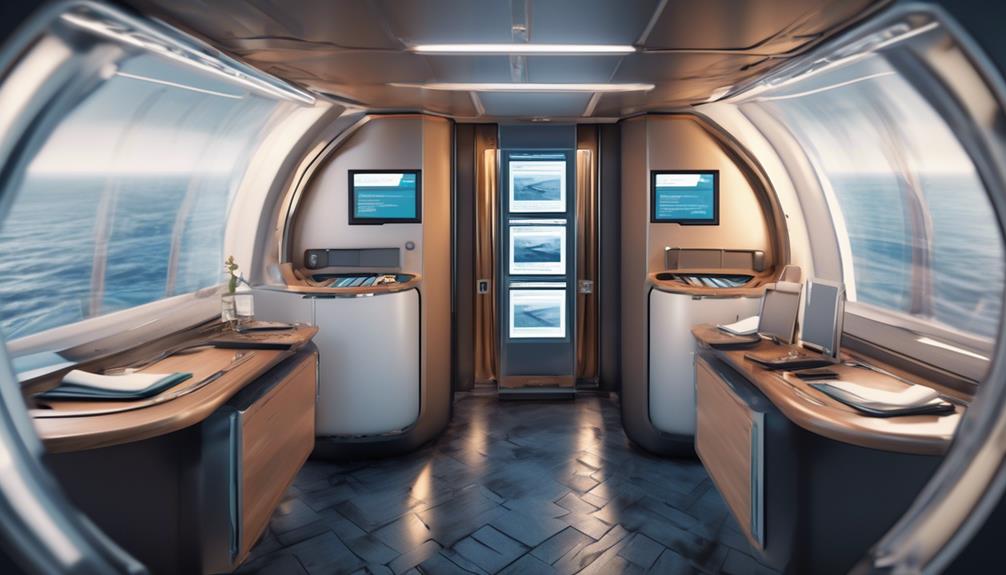
We'll now address the importance of document organization and preventing loss of important documents while on a cruise.
Securing important documents such as passports, identification, and travel tickets is crucial for a smooth and stress-free travel experience. By implementing effective strategies, such as using secure document holders and keeping digital copies, travelers can minimize the risk of misplacing or losing essential paperwork.
Document Organization
To ensure the security and organization of important documents, it's crucial to establish a systematic filing system with designated storage areas on the cruise ship. Utilizing magnetic storage solutions can effectively secure documents in place, preventing loss or damage during the ship's movement.
Magnetic document display boards can be strategically placed in crew areas and offices, allowing for easy access to essential information while maintaining a clutter-free environment.
When organizing documents, it's important to categorize them based on their frequency of use and relevance, ensuring that frequently accessed documents are readily available.
Additionally, implementing a standardized naming convention and color-coding system can further enhance document organization, facilitating quick identification and retrieval.
Preventing Loss
Utilizing magnetic storage solutions on a cruise ship enhances document security by preventing loss or damage during the vessel's movement. Preventing theft and organizing belongings becomes crucial when personal and valuable documents are involved.
Magnetic pockets and holders offer a secure way to store passports, tickets, and other essential papers, minimizing clutter and ensuring easy access. By strategically placing magnets in our cabin, we can personalize our space while keeping important documents in a designated, secure location.
This method not only prevents the misplacement of crucial items but also safeguards them from potential theft. With magnetic storage solutions, we can optimize our cabin's layout, creating a functional and organized environment that minimizes the risk of losing important documents during our cruise.
Displaying Cruise Itinerary
We've found that organizing our cruise itinerary can greatly enhance our overall experience. By visually displaying our schedule, we can easily keep track of activities and make the most of our time on board.
Additionally, the customization options allow us to tailor our display to fit our specific needs and preferences.
Itinerary Organization Tips
Displaying the cruise itinerary using magnets provides a practical and visually effective way to organize and communicate the schedule to passengers. By using a magnetic whiteboard or sheet, the itinerary can be easily updated, and passengers can quickly see the day's events. Here are some itinerary organization tips to ensure smooth sailing:
| Time | Activity | Location |
|---|---|---|
| 8:00 AM | Breakfast Buffet | Main Dining Room |
| 10:00 AM | Shore Excursion | Port of Call |
| 1:00 PM | Onboard Activity | Pool Deck |
| 6:00 PM | Fine Dining Dinner | Specialty Restaurant |
| 9:00 PM | Evening Show | Theater |
Carefully organizing the itinerary with clear time slots, activities, and locations will help passengers make the most of their cruise experience. Utilizing magnets for this purpose ensures that the schedule remains visible and easily accessible throughout the voyage.
Benefits of Visual Display
When organizing a cruise itinerary, visual display through the use of magnets provides a practical and visually effective method for communicating the schedule to passengers, ensuring easy updates and quick access to the day's events.
Visual merchandising techniques, such as interactive displays using magnets, offer several benefits for cruise itineraries. Firstly, it allows for the clear presentation of the daily schedule, including activities, dining options, and entertainment, in a centralized location. This enhances passengers' awareness and anticipation of the day's events.
Secondly, interactive displays with magnets enable easy adjustments to the itinerary, accommodating any changes or additions seamlessly. Passengers can also personalize their schedules by rearranging magnets as per their preferences, fostering engagement and a sense of control over their cruise experience.
Ultimately, utilizing magnets for visual display enhances the overall cruise experience by providing clear, interactive, and easily updatable itinerary information.
Customization Options
Utilizing customizable magnetic displays for the cruise itinerary allows for personalized scheduling options and seamless updates, enhancing passenger engagement and control over their experience. By using decorative magnets, passengers can create personalized souvenirs that capture their unique journey. These magnets not only serve as practical tools for displaying the cruise itinerary but also as mementos of the places visited and experiences enjoyed. The following table illustrates how the cruise itinerary can be visually displayed using customizable magnetic displays, providing passengers with a clear and personalized overview of their journey.
| Day | Activity | Location |
|---|---|---|
| Day 1 | Welcome Party | Departure Port |
| Day 2 | Excursion | Caribbean Island |
| Day 3 | Onboard Activities | At Sea |
| Day 4 | Shore Excursion | Mexican Riviera |
Keeping Track of Stateroom Keys

To maintain security and streamline access, we employ a sophisticated key tracking system for staterooms on our cruise ships. Key management is a critical aspect of ensuring the safety and privacy of our guests, as well as the security of onboard facilities. Our access control system utilizes advanced technology to monitor and manage the distribution and usage of stateroom keys.
Each stateroom key is uniquely coded and registered in our key management database. When a key is issued to a guest, it's linked to their personal information, allowing us to track its usage throughout the ship. This not only provides us with a comprehensive record of who's access to each stateroom but also enables us to quickly deactivate lost or stolen keys, enhancing overall security.
Furthermore, our access control system allows us to restrict entry to certain areas of the ship based on the authorization level of each key. This ensures that only authorized personnel and guests can access specific locations, adding an extra layer of protection to sensitive areas.
Hanging Light Items
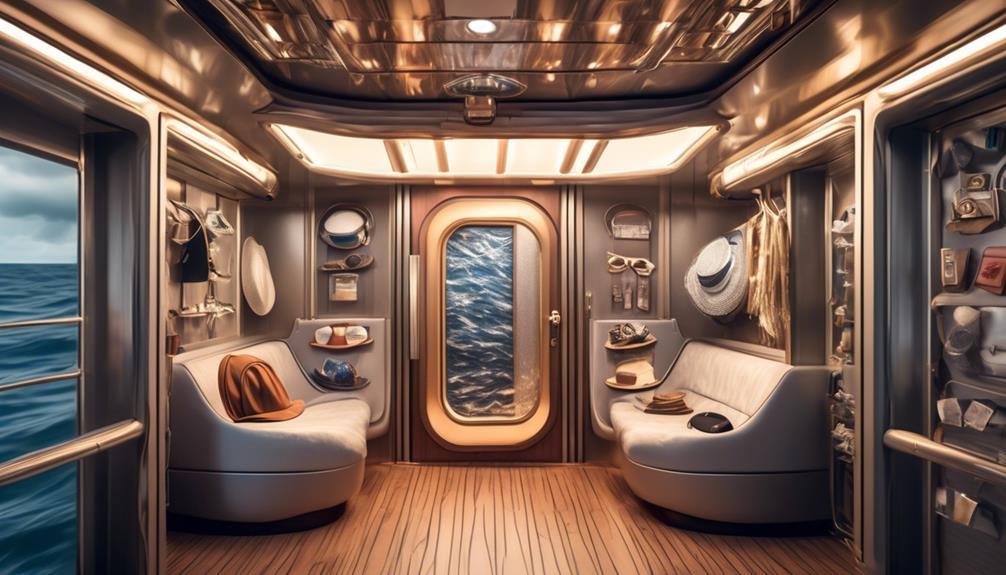
Our cruise ship's advanced key tracking system, vital for security, also allows us to address the topic of hanging light items. When it comes to displaying magnetic art or hanging jewelry in staterooms, the presence of magnets on a cruise ship is indispensable. Magnets provide a secure and versatile way to exhibit lightweight items without causing damage to the walls or surfaces.
The cabins are equipped with metal surfaces that are specifically designed to accommodate magnets, enabling passengers to personalize their living spaces with magnetic art or to safely hang their jewelry for easy access.
In the context of magnetic art, our ship's magnetic-friendly walls offer a unique opportunity for passengers to express their creativity and individuality. With the use of small, lightweight magnets, guests can easily display art prints, postcards, or other magnetic decor without the need for adhesives or hardware.
Additionally, the magnetic surfaces in the staterooms provide a convenient and safe solution for hanging jewelry, ensuring that delicate items are kept organized and accessible throughout the voyage.
Creating DIY Cabin Decor
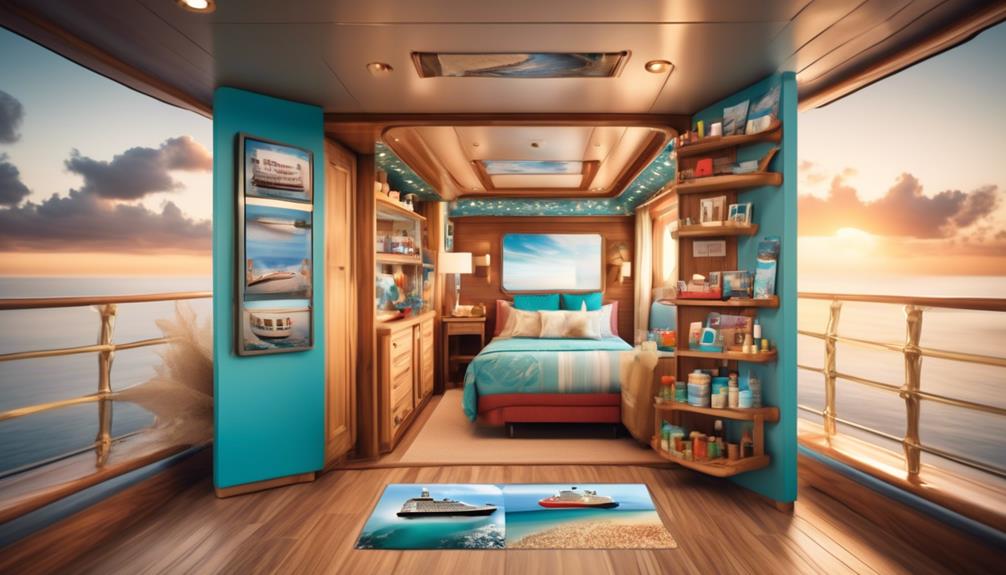
We can enhance our cabin decor by using magnets to create a magnetic photo display, allowing us to showcase our favorite memories without damaging the walls.
Additionally, organizing with magnets can help maximize the limited space in our cabin, keeping items like keys, sunglasses, and small accessories easily accessible and in order.
Magnetic Photo Display
When creating DIY cabin decor, consider utilizing a magnetic photo display to efficiently showcase your favorite memories without the need for nails or adhesives. A magnetic photo display offers a versatile and practical way to exhibit your photos and artwork while cruising. It provides a secure and easily changeable method for presenting your creative display.
Here are some benefits of using a magnetic photo display:
- Versatility: The ability to rearrange and switch out photos or artwork effortlessly.
- Damage-free: Eliminates the need for nails, tacks, or adhesives that could damage cabin walls.
- Space-saving: Maximizes wall space in your cabin without cluttering it with frames or shelves.
- Personalization: Allows for a customizable and ever-changing display of magnetic art.
Organizing With Magnets
Utilizing magnetic organizers in DIY cabin decor allows for efficient utilization of space and easy reconfiguration of storage solutions. When creating DIY cabin decor on a cruise ship, magnetic menus and cruise souvenirs can be used in innovative ways to organize and decorate the cabin. Below is a table showing some ideas for organizing with magnets:
| Organizing with Magnets | Description |
|---|---|
| Magnetic Menu Board | Use a magnetic board to display daily menus and keep them easily accessible. |
| Magnetic Photo Display | Showcase cruise memories by creating a magnetic photo display on a cabin wall. |
| Magnetic Souvenir Holder | Attach magnets to small containers to create a souvenir holder on the cabin wall. |
| Magnetic Spice Rack | Use magnetic spice containers to create a space-saving and easily accessible spice rack. |
| Magnetic Key Holder | Install a magnetic key holder near the door for easy access to cabin keys.
Storing Small Metal Items
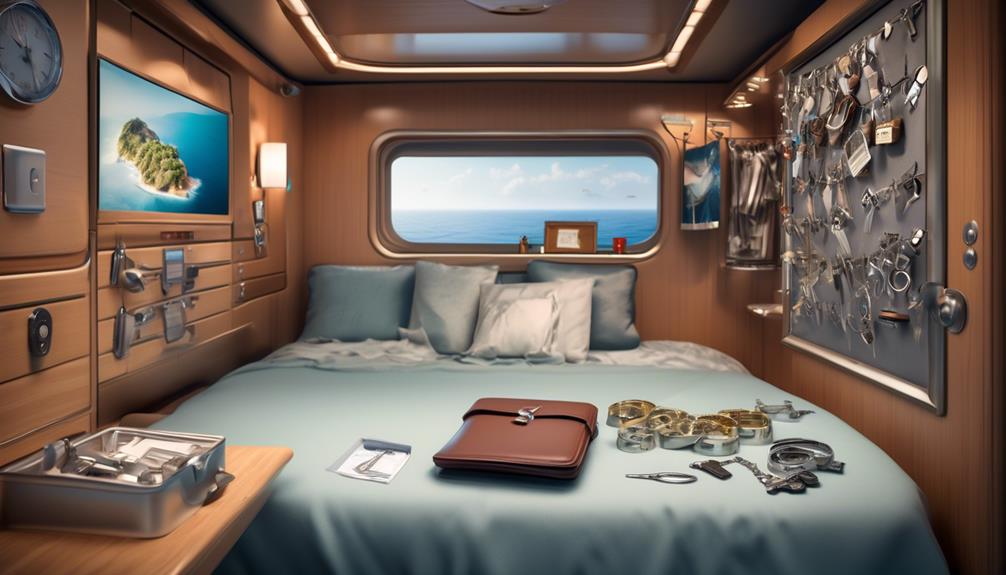
Metal items can be securely stored by utilizing small, strong magnets in designated areas. Magnetic storage offers an efficient solution for organizing small metal items on a cruise ship. Here are key ways to optimize metal organization using magnets:
- Cabin Walls: Utilize magnetic strips or boards on cabin walls to store small metal items such as nail clippers, tweezers, and scissors, keeping them easily accessible yet neatly organized.
- Bathroom: Install magnetic containers on the inside of bathroom cabinets or on the shower caddy to store bobby pins, hair clips, or safety pins, preventing them from cluttering surfaces.
- Workstation: Attach magnetic trays to workstations in craft rooms or offices for keeping paper clips, push pins, and other metal stationery items within reach and in order.
- Outdoor Areas: Use magnetic hooks or containers on outdoor decks to store items like bottle openers or small tools, preventing them from getting lost or causing a safety hazard.
Marking Personal Belongings
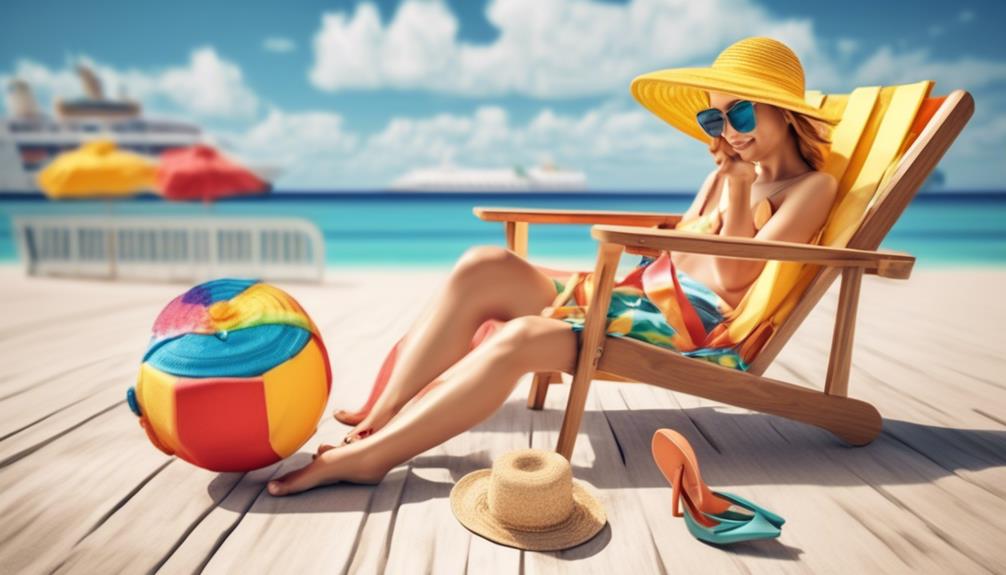
We need to consider the best ways to organize our cabin space and secure our towels and clothing while on a cruise ship.
By marking our personal belongings with magnets, we can efficiently designate specific areas for our items and prevent them from getting mixed up or misplaced.
This method can help us maintain a tidy and organized living space throughout the duration of the cruise.
Organizing Cabin Space
To maintain a clear and organized cabin space on a cruise ship, it's essential to accurately label and secure personal belongings using magnets. By doing so, one can effectively make use of limited space and ensure that items are kept in designated areas.
Here are key strategies for organizing cabin space:
- Utilize magnetic hooks to hang lightweight items such as hats, scarves, and lanyards on metal surfaces.
- Label storage containers with magnetic labels to easily identify contents and maintain order within limited storage space.
- Attach magnetic clips to the walls or metal surfaces to hold important documents, itineraries, or daily schedules.
- Use magnetic strips to secure small essentials like keys, small tools, or personal care items to prevent them from cluttering countertops or getting misplaced.
Securing Towels and Clothing
When securing towels and clothing on a cruise ship, it is advisable to use magnetic hooks or clips to prevent them from cluttering the cabin space and ensure their easy accessibility. Magnetic towel hooks and clothing hangers can be strategically placed to maximize space and keep personal items organized. Here's a comparison between magnetic towel hooks and clothing hangers:
| Magnetic Towel Hooks | Clothing Hangers |
|---|---|
| Strong magnetic force | Secure grip on clothes |
| Space-saving | Prevents wrinkling |
| Multipurpose | Durable and reusable |
| Easy to install | Various sizes available |
| Rust-resistant | Versatile usage |
Preventing Paper Clutter

Using a magnetic filing system can effectively prevent paper clutter on a cruise ship. Paperless organization and digital solutions are essential for efficient management of documents on board. Sustainable practices, such as reducing waste, can be achieved by minimizing the use of paper.
By implementing a magnetic filing system, the following benefits can be realized:
- Enhanced Organization: Magnetic filing systems provide a systematic approach to organizing documents, ensuring easy access and retrieval of information when needed.
- Space Optimization: With reduced paper clutter, valuable space can be optimized for other essential purposes, contributing to a more efficient and functional environment.
- Environmental Impact: By reducing the reliance on paper, cruise ships can significantly lower their environmental footprint, aligning with sustainable practices and environmental regulations.
- Reduced Operational Costs: Embracing paperless solutions not only reduces the expenses associated with paper procurement and storage but also streamlines operational processes, leading to cost savings.
Assisting With Kids' Activities
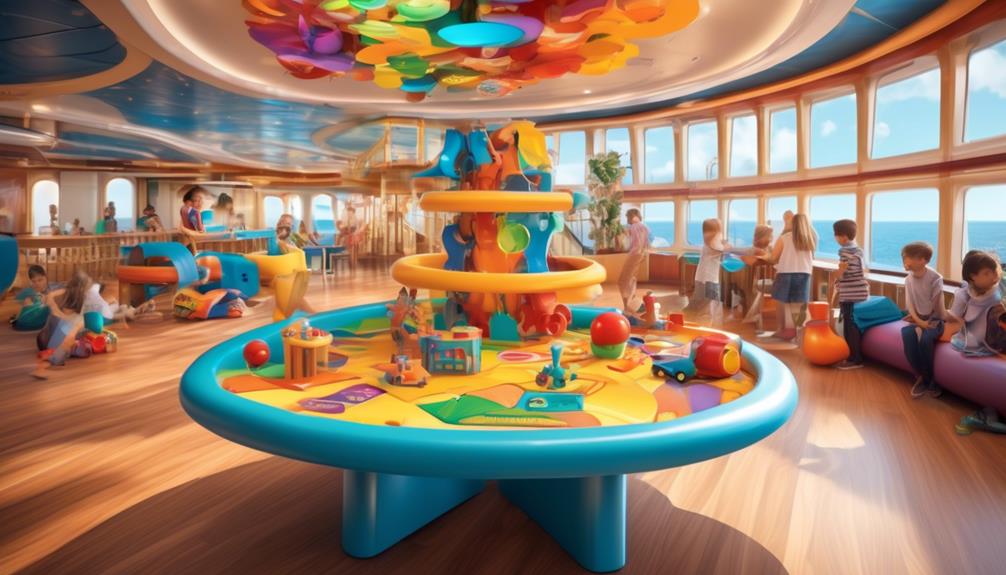
Having established the benefits of a magnetic filing system for paperless organization on a cruise ship, our focus now shifts to optimizing the use of magnets for assisting with kids' activities on board. When it comes to entertainment options for children, magnets can be utilized to create interactive and engaging spaces. By using magnetic boards and tiles, the ship's crew can set up various activity stations such as magnetic puzzles, drawing boards, and storytelling areas. Additionally, safety measures can be enhanced by using magnets to secure play areas and hold down loose items during rough seas.
| Entertainment Options | Safety Measures | Magnetic Boards & Tiles |
|---|---|---|
| Magnetic puzzles | Secure play areas | Interactive drawing boards |
| Storytelling areas | Hold down loose items | Activity stations |
These measures not only provide entertainment for children but also contribute to their safety and well-being on board. By employing magnets strategically, cruise ships can offer a diverse range of activities for kids while ensuring a secure environment.
Supporting Magnetic Hooks
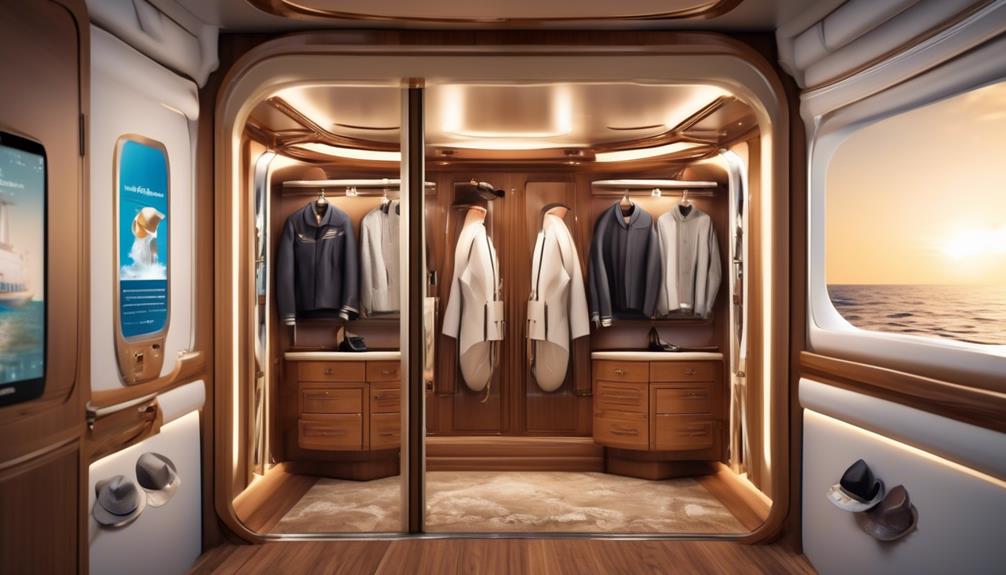
We can enhance the functionality of the ship's interior by strategically placing magnetic hooks in key areas for efficient storage and organization. Magnetic storage and hook organization are crucial for maintaining a tidy and organized ship environment. Here are the key ways in which supporting magnetic hooks can significantly improve the ship's interior:
- Maximizing Space Utilization: Magnetic hooks allow us to make use of vertical spaces, such as cabin walls and metal surfaces, for hanging items like hats, bags, and lightweight equipment, freeing up valuable shelf and floor space.
- Securing Items During Travel: By utilizing magnetic hooks, we can securely fasten items in place, preventing them from shifting or falling during the ship's movements, ensuring a safe and organized environment.
- Quick and Easy Access: Placing magnetic hooks near entrances and activity areas allows for quick access to frequently used items, such as jackets or towels, keeping them within reach and neatly stored.
- Adaptable Storage Solutions: Magnetic hooks offer a versatile and easy-to-reconfigure storage solution, allowing for swift adjustments to accommodate varying storage needs throughout the cruise.
Strategic placement of magnetic hooks ensures efficient use of space, easy access to essential items, and a well-organized ship interior, ultimately enhancing the overall cruise experience.
Personalizing Cabin Walls

To optimize the functionality of the ship's interior and create a personalized living space, the strategic utilization of cabin walls becomes pivotal. Cabin decoration and wall organization are essential to maximize the use of space and create a comfortable environment. By personalizing cabin walls, passengers can not only express their individuality but also enhance the functionality of their living space. Here is a table that showcases various ways to personalize cabin walls for both aesthetic appeal and practical use:
| Organization | Decoration | Functionality |
|---|---|---|
| Magnetic hooks for hanging hats, bags, and accessories | Photo frames and artwork | Wall-mounted shelves for storage |
| Corkboard for pinning notes, reminders, and travel memorabilia | String lights and decorative banners | Hanging organizers for toiletries and small items |
| Whiteboard for planning itineraries and leaving messages | Mirror and wall decals | Hooks and racks for hanging towels and clothing |
Organizing Sea Pass Cards
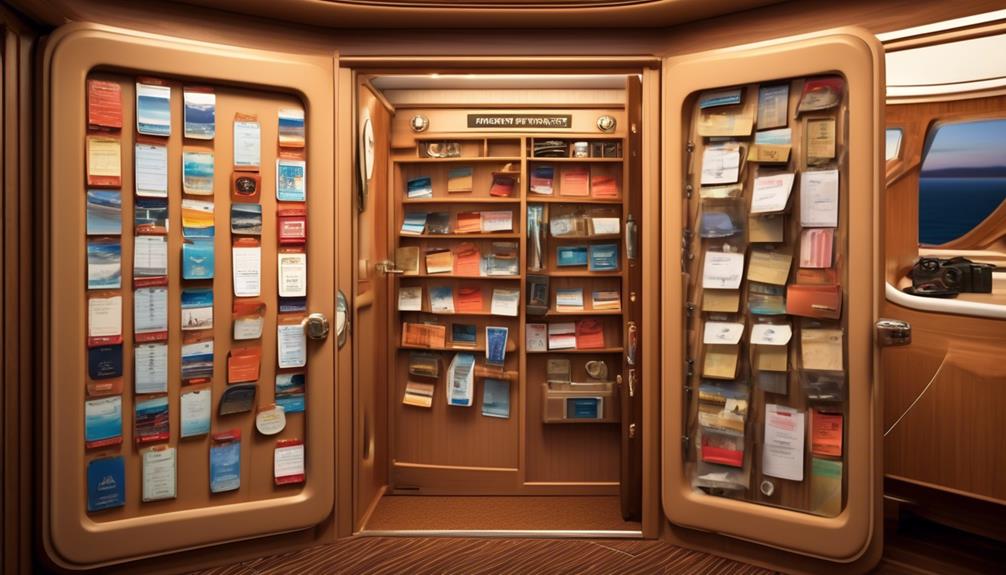
Sea Pass cards can be efficiently organized using designated card holders or secure pockets within close proximity to cabin entrances. When on a cruise vacation, keeping Sea Pass cards easily accessible is essential for seamless navigation around the ship. Here are several options for organizing Sea Pass cards:
- Sea Pass Holders: These specially designed holders offer a convenient way to keep Sea Pass cards secure and easily accessible. They can be attached to lanyards, clothing, or bags for quick retrieval when needed.
- Magnetic Organization: Utilizing magnetic hooks or strips near the cabin entrance provides a hands-free option for storing Sea Pass cards. This ensures they're always within reach as you enter or exit the cabin.
- Secure Pockets: Installing small, secure pockets near the cabin door allows for the safekeeping of Sea Pass cards. This method ensures that the cards are always in a designated location, minimizing the risk of misplacement.
- Personalized Solutions: Some travelers opt for personalized organizational methods such as decorative pouches or hooks that complement the cabin's decor while providing easy access to Sea Pass cards.
These strategies not only contribute to a streamlined experience but also reduce the likelihood of misplacing Sea Pass cards during the cruise.
Securing Towels and Clothing

Utilizing the same organizational principles applied to Sea Pass cards, securing towels and clothing on a cruise ship involves implementing efficient storage solutions to ensure easy access and minimize the risk of misplacement.
Towel holders are strategically placed in the staterooms and near pool areas to provide designated spots for hanging and drying towels. These holders are often made of durable materials such as stainless steel or plastic and are designed to withstand the marine environment.
Additionally, clothing organizers, including collapsible fabric shelves and hanging closet organizers, are commonly utilized to maximize the use of available space within the stateroom. These organizers typically feature compartments and pockets for segregating different clothing items, keeping them neatly arranged and easily accessible.
Sharing Memorable Photos

Passengers often choose to share their memorable photos from the cruise by utilizing the ship's designated photo sharing kiosks located in high-traffic areas onboard. These kiosks are equipped with user-friendly interfaces, allowing passengers to conveniently upload and share their favorite cruise moments with friends and family.
Here's why the photo sharing kiosks are an essential aspect of the cruise experience:
- Convenience: The strategically placed kiosks save passengers the hassle of carrying around physical photos or relying solely on digital sharing platforms.
- Photo journaling: Passengers can use the kiosks to create digital photo journals of their cruise experience, organizing and captioning photos to preserve memories in a structured and artistic manner.
- Scrapbook memories: The kiosks enable passengers to craft digital scrapbooks, arranging and personalizing their photos to create lasting mementos of their cruise.
- Social sharing: In addition to physical prints, passengers can instantly share their photos on social media platforms directly from the kiosks, fostering a sense of community and allowing friends and family to virtually partake in the cruise experience.
These kiosks not only facilitate sharing but also add a layer of convenience and creativity to the process of preserving and reliving cherished memories from the cruise.
Frequently Asked Questions
How Do Magnets Help With Organizing Sea Pass Cards and Securing Towels and Clothing on a Cruise Ship?
When organizing documents, magnets on a cruise ship are essential for securing belongings like sea pass cards and towels. The magnets provide a reliable way to keep these items in place, preventing loss or misplacement.
Can Magnets Be Used to Display and Share Memorable Photos While on a Cruise?
Magnetic photo frames are an excellent way to display and share memorable photos while on a cruise. They offer a secure and convenient method for showcasing cruise ship souvenirs, creating a personalized environment in the cabin.
These frames provide a practical and aesthetic solution for preserving cherished memories, allowing easy rearrangement and replacement of displayed photos. Plus, they add a touch of home to the cruise experience, making the cabin feel cozy and familiar.
Are There Specific Types of Magnets That Are Best for Supporting Magnetic Hooks and Creating DIY Cabin Decor on a Cruise Ship?
For the best magnet types, neodymium magnets are ideal for supporting magnetic hooks due to their strong magnetic pull.
When creating DIY cabin decor on a cruise ship, flexible magnetic sheets are versatile and easy to use for magnetic photo display and other decorative purposes.
These magnets offer strong adhesion and flexibility, allowing for creative and functional organization.
How Can Magnets Assist With Kids' Activities on a Cruise Ship?
Using magnets for kids' entertainment on a cruise ship is ingenious.
Magnetic art can keep kids engaged for hours, fostering creativity and imagination. By providing magnetic canvases and pieces, children can create unique artworks that can be displayed proudly in the cabin.
Magnetic puzzles and games are also great for stimulating young minds.
These activities not only entertain kids but also provide a sense of accomplishment, making the cruise experience memorable for the whole family.
Can Magnets Be Used to Prevent Paper Clutter and Assist in Keeping Track of Stateroom Keys While on a Cruise?
To prevent clutter and keep track of stateroom keys on a cruise, magnets are essential tools.
By using magnets, we can easily organize important documents and prevent them from scattering around the stateroom.
Additionally, attaching stateroom keys to magnets ensures that they're always within reach and not easily misplaced.
This practical application of magnets provides a simple yet effective solution for maintaining tidiness and managing essential items during a cruise.
Conclusion
In conclusion, magnets are essential on a cruise ship for organizing, securing, and personalizing various items and spaces. They act as the glue that holds everything together, much like the way they attract and hold onto metal objects.
Without them, keeping track of important documents, keys, and daily schedules would be a chaotic mess. Therefore, magnets aren't just a convenience, but a necessity for a smooth and organized cruise experience.
- About the Author
- Latest Posts
Introducing Ron, the home decor aficionado at ByRetreat, whose passion for creating beautiful and inviting spaces is at the heart of his work. With his deep knowledge of home decor and his innate sense of style, Ron brings a wealth of expertise and a keen eye for detail to the ByRetreat team.
Ron’s love for home decor goes beyond aesthetics; he understands that our surroundings play a significant role in our overall well-being and productivity. With this in mind, Ron is dedicated to transforming remote workspaces into havens of comfort, functionality, and beauty.
-
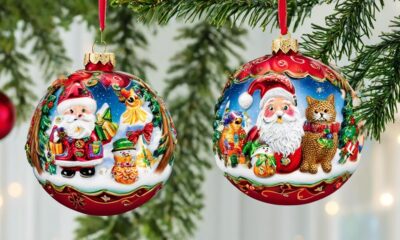
 Chinese New Year Decorations4 weeks ago
Chinese New Year Decorations4 weeks agoMost Valuable Christopher Radko Ornaments
-

 Mardi Gras Decoration3 weeks ago
Mardi Gras Decoration3 weeks agoWhat Should I Wear to a Mardi Gras Ball?
-

 Mardi Gras Decoration3 weeks ago
Mardi Gras Decoration3 weeks agoWhen Should I Decorate for Mardi Gras?
-
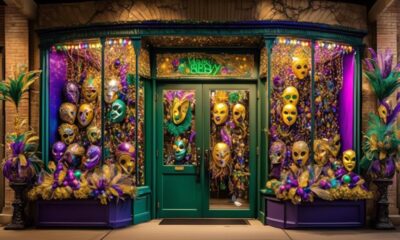
 Mardi Gras Decoration4 weeks ago
Mardi Gras Decoration4 weeks agoDoes Hobby Lobby Have Mardi Gras Decorations
-

 Mardi Gras Decoration3 weeks ago
Mardi Gras Decoration3 weeks agoHow Should I Dress for a Mardi Gras Gala?
-

 Mardi Gras Decoration4 weeks ago
Mardi Gras Decoration4 weeks agoWhat Should I Wear to a Mardi Gras Party?
-
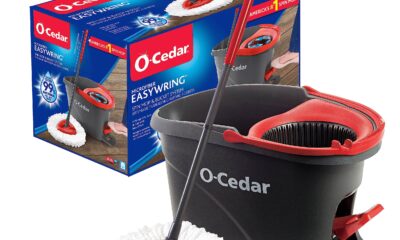
 Vetted5 days ago
Vetted5 days agoBest Mop for Sparkling Clean Floors in 2024
-

 Mardi Gras Decoration3 weeks ago
Mardi Gras Decoration3 weeks agoWhat Is a Mardi Gra Theme?







